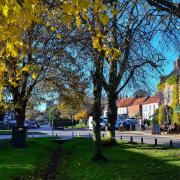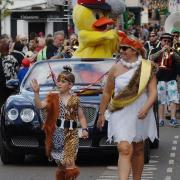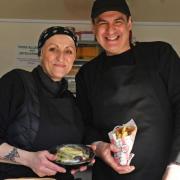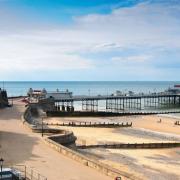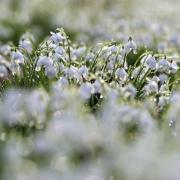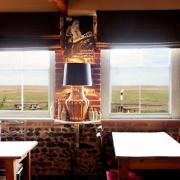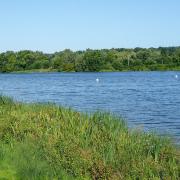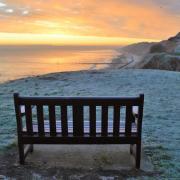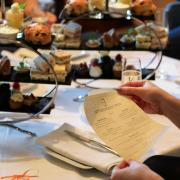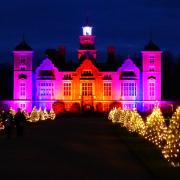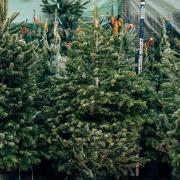Take a step back in time and celebrate an old fashioned Christmas at Blickling Hall,

Standing majestic against the dark sky, illuminated by the warm glow of the light decked trees which line its impressive drive, Blickling Hall never looks more magnificent than on a crisp, bright festive night.
One of Norfolk’s most iconic landmarks – built in the early 17th century - the striking red brick Jacobean house has a long and rich history, and was left to the National Trust in 1940 by Philip Kerr, 11th Marquis of Lothian.
Once home to the aristocracy and the birthplace of Henry VIII’s ill-fated wife Anne Boleyn, the grand state rooms will have doubtlessly hosted many lively and decadent Christmases over the centuries – but it is the past 100 years which inspire celebrations today. During the festive period, events are held to explore what life would have been like at Christmas during the 1930s, when the focus was very much on those who lived and worked on the estate. The kitchen becomes a hive of activity, preparing and serving traditional food and drink, and the hall itself is transformed into a stunning, festive wonderland, reflecting the period – when decorations would have included bells, balls, tinsel and golden haired angels, hand-blown ornaments and colourful paper chains made by children.
This winter there are 48 trees lining the drive and temple walk which are lit by 19,200 lights – taking two separate departments two days to put up, and 10,500 paper chain links decorate the garden. Back in the house, a team of 50 volunteers spend three days decorating the rooms in a traditional style.

Place in history
The last owner of Blickling, the 11th Marquis of Lothian, was a diplomat and politician and played a leading part in helping defeat Hitler, thanks to his success in winning American support for the British war effort. But his international commitments meant he was never at Blickling at Christmas – in fact, he was a Christian Scientist and it isn’t known whether he celebrated it at all.
Closer to home, Blickling also played a key role in the conflict. In 1939, the RAF Oulton bomber base was created on the estate, enabling Blenheim and Fortress bombers to take off and land. The hall was requisitioned during this period, accommodating officers in the hall and other ranks in Nissen huts in the grounds.
National Trust curator Mike Sutherill says: “Archives show that the RAF based at Blickling took part in operations around Christmas time of 1944, in fact they arrived home on Christmas Eve. It was common practice for the officers to then serve the airmen dinner on Christmas Day. Thankfully they all returned safely that day but seven aircraft who did fly on Christmas Day from the surrounding bases were not so lucky.”
Creating the big day
The Christmas feast would have been a memorable occasion on the estate over the centuries. But during the 1930s, with the owner away, it was the staff who would have celebrated together – enjoying a dinner on Christmas Eve before being allowed to return home, if they lived locally, for a day off on Christmas Day.
But, says Liz Scott who looks after the 1930s cookery in the kitchen at Blickling, they would have soon been back on duty.
“They had to be back on Boxing Day because the Harriers met at the front of the hall and needed to be served drinks and titbits,” she says. “The kitchen staff – which comprised of a cook, kitchen maid and scullery maid had a sitting room and the house maids had a different room next door.
“Trades-people in Aylsham would have provided much of the kitchen supplies - Ward and George’s, the grocers in the market place, would come to the hall and take the order, as would Mr Partridge, the butcher. Mr Balls was the fishmonger and goods came by van if it was a large order, or by a boy on a bike with a big basket. Milk and cream came from Brick Kiln Farm and Percy Aldgate, one of the under-gardeners, would shoot rabbits on the estate to provide rabbit meat for casseroles, pies or stew for the staff,” says Liz.
“Work started every day at 6.30am and all the cooking was done on two ovens on the range cooker lit by the scullery maid every day.”
At Christmas, the team at Blickling recreates the food which would have been cooked and served during the festive period in the 1930s.
“We will make gingerbread men, sweets and marzipan, decorate the cake we made in October, make mince pies with the mincemeat we also made in October and then re-steam the Christmas puddings, along with some brandy butter and mulled wine and cider. Everything we do is based on 1930s style recipes and made in the 1930s fashion - no modern food processors or microwaves.”




